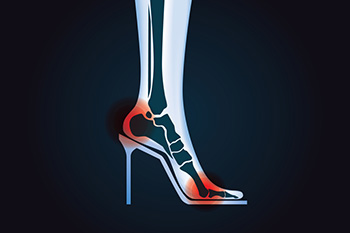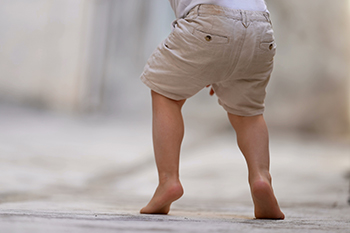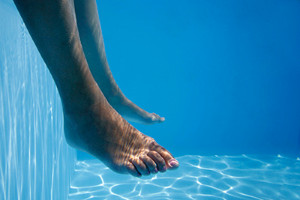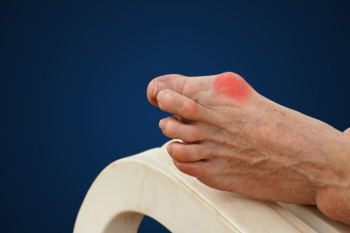Items filtered by date: January 2025
Heel Pain Can Be Treated!
Why Wearing High Heels May Cause Foot Pain

Wearing high heels can lead to a variety of foot problems due to the unnatural positioning and pressure they place on the feet. High heels force the toes into a confined space and push the body’s weight forward, increasing pressure on the toes and the ball of the foot. This can lead to painful conditions such as bunions, corns, and calluses. Over time, wearing high heels can also cause shortening and tightening of the Achilles tendon, leading to Achilles tendinitis or heel pain. Additionally, the elevated heel alters the natural alignment of the spine and joints, potentially causing back and knee pain. High heels can also contribute to the development of plantar fasciitis due to the strain they place on the bottom of the foot. While wearing high heels occasionally may not cause immediate harm, frequent use can lead to long-term foot and joint problems. If you have foot pain from wearing high heels, it is suggested that you confer with a podiatrist who can treat various foot conditions, and educate you on more appropriate shoes to wear.
High heels have a history of causing foot and ankle problems. If you have any concerns about your feet or ankles, contact Charles Perry, DPM from Ohio. Our doctor can provide the care you need to keep you pain-free and on your feet.
Effects of High Heels on the Feet
High heels are popular shoes among women because of their many styles and societal appeal. Despite this, high heels can still cause many health problems if worn too frequently.
Which Parts of My Body Will Be Affected by High Heels?
- Ankle Joints
- Achilles Tendon – May shorten and stiffen with prolonged wear
- Balls of the Feet
- Knees – Heels cause the knees to bend constantly, creating stress on them
- Back – They decrease the spine’s ability to absorb shock, which may lead to back pain. The vertebrae of the lower back may compress.
What Kinds of Foot Problems Can Develop from Wearing High Heels?
- Corns
- Calluses
- Hammertoe
- Bunions
- Morton’s Neuroma
- Plantar Fasciitis
How Can I Still Wear High Heels and Maintain Foot Health?
If you want to wear high heeled shoes, make sure that you are not wearing them every day, as this will help prevent long term physical problems. Try wearing thicker heels as opposed to stilettos to distribute weight more evenly across the feet. Always make sure you are wearing the proper shoes for the right occasion, such as sneakers for exercising. If you walk to work, try carrying your heels with you and changing into them once you arrive at work. Adding inserts to your heels can help cushion your feet and absorb shock. Full foot inserts or metatarsal pads are available.
If you have any questions please feel free to contact our offices located in Cambridge and Zanesville, OH . We offer the newest diagnostic and treatment technologies for all your foot and ankle needs.
Understanding Child Toe Walking and Its Causes

Toe walking is a common behavior observed in children, where they walk on their toes rather than with their feet flat on the ground. One of the primary causes of toe walking is habitual behavior, where children simply adopt this pattern without any underlying medical issue. However, in some cases, toe walking may be linked to sensory processing differences, where children may prefer the sensation of walking on their toes due to heightened or reduced sensitivity to touch. Another cause is tight calf muscles, which may restrict the ability to walk normally and lead to toe walking as a compensatory movement. Neurological conditions, such as cerebral palsy or other motor disorders, can also contribute to toe walking due to muscle weakness or coordination issues. In any case, if toe walking persists beyond early childhood, it is suggested that you consult a podiatrist who can assess the cause and determine the most appropriate course of action.
Making sure that your children maintain good foot health is very important as they grow. If you have any questions, contact Charles Perry, DPM of Ohio. Our doctor can provide the care you need to keep you pain-free and on your feet.
Keeping Children's Feet Healthy
Having healthy feet during childhood can help prevent medical problems later in life, namely in the back and legs. As children grow, their feet require different types of care. Here are some things to consider...
Although babies do not walk yet, it is still very important to take care of their feet.
Avoid putting tight shoes or socks on his or her feet.
Allow the baby to stretch and kick his or her feet to feel comfortable.
As a toddler, kids are now on the move and begin to develop differently. At this age, toddlers are getting a feel for walking, so don’t be alarmed if your toddler is unsteady or ‘walks funny’.
As your child gets older, it is important to teach them how to take care of their feet.
Show them proper hygiene to prevent infections such as fungus.
Be watchful for any pain or injury.
Have all injuries checked by a doctor as soon as possible.
Comfortable, protective shoes should always be worn, especially at play.
If you have any questions please feel free to contact our offices located in Cambridge and Zanesville, OH . We offer the newest diagnostic and treatment technologies for all your foot and ankle needs.
Exercise and Diabetic Foot Ulcers

Exercise offers significant physical and psychological benefits for individuals with diabetic foot ulcers, or DFUs, but it comes with unique challenges. Obesity and a sedentary lifestyle among those with diabetes can make initiating physical activity difficult. Excess weight places additional pressure on the feet, increasing the risk of ulcer progression or delayed healing. Yet, carefully tailored exercise programs can improve circulation, enhance glucose control, and reduce obesity-related strain, fostering a healthier body and aiding wound recovery. Psychologically, exercise promotes mental well-being by reducing stress, anxiety, and depression, which are prevalent in those managing chronic conditions like DFUs. To mitigate risks, exercises must focus on low-impact activities such as swimming, cycling, or seated routines, guided by a podiatrist. If you have diabetes and are experiencing foot ulcers, it is strongly suggested that you visit a podiatrist for a comprehensive treatment plan, including an examination, any wound care that is necessary, and suggestions of safe and effective physical activity
Exercising your feet regularly with the proper foot wear is a great way to prevent injuries and build strength. If you have any concerns about your feet, contact Charles Perry, DPM from Ohio. Our doctor can provide the care you need to keep you pain-free and on your feet.
Exercise for Your Feet
Exercise for your feet can help you gain strength, mobility and flexibility in your feet. They say that strengthening your feet can be just as rewarding as strengthening another part of the body. Your feet are very important, and we often forget about them in our daily tasks. But it is because of our feet that are we able to get going and do what we need to. For those of us fortunate enough to not have any foot problems, it is an important gesture to take care of them to ensure good health in the long run.
Some foot health exercises can include ankle pumps, tip-toeing, toe rises, lifting off the floor doing reps and sets, and flexing the toes. It is best to speak with Our doctor to determine an appropriate regimen for your needs. Everyone’s needs and bodies are different, and the activities required to maintain strength in the feet vary from individual to individual.
Once you get into a routine of doing regular exercise, you may notice a difference in your feet and how strong they may become.
If you have any questions please feel free to contact our offices located in Cambridge and Zanesville, OH . We offer the newest diagnostic and treatment technologies for all your foot and ankle needs.
The Truth About Bunions

Bunions are bony bumps that form at the base of the big toe causing it to lean toward the other toes. They often look unsightly and can be painful, especially when wearing tight or narrow shoes. Bunions develop over time due to factors like genetics, foot structure, arthritis, or wearing ill-fitting footwear. While some people experience no pain, others may suffer from redness, swelling, and discomfort, particularly after prolonged walking or standing. Bunions are more common in women, likely due to shoe choices, and in those with a family history of the condition. Unfortunately, bunions do not go away on their own. They may worsen without intervention. Treatment includes wearing wider shoes, using orthotics, or padding the bunion to reduce friction. For severe cases, surgery may be necessary. If you have a painful bunion, it is suggested that you visit a podiatrist who can assess your bunions and recommend the best treatment plan.
If you are suffering from bunion pain, contact Charles Perry, DPM of Ohio. Our doctor can provide the care you need to keep you pain-free and on your feet.
What Is a Bunion?
Bunions are painful bony bumps that usually develop on the inside of the foot at the joint of the big toe. As the deformity increases over time, it may become painful to walk and wear shoes. Women are more likely to exacerbate existing bunions since they often wear tight, narrow shoes that shift their toes together. Bunion pain can be relieved by wearing wider shoes with enough room for the toes.
Causes
- Genetics – some people inherit feet that are more prone to bunion development
- Inflammatory Conditions - rheumatoid arthritis and polio may cause bunion development
Symptoms
- Redness and inflammation
- Pain and tenderness
- Callus or corns on the bump
- Restricted motion in the big toe
In order to diagnose your bunion, your podiatrist may ask about your medical history, symptoms, and general health. Your doctor might also order an x-ray to take a closer look at your feet. Nonsurgical treatment options include orthotics, padding, icing, changes in footwear, and medication. If nonsurgical treatments don’t alleviate your bunion pain, surgery may be necessary.
If you have any questions, please feel free to contact our offices located in Cambridge and Zanesville, OH . We offer the newest diagnostic and treatment technologies for all your foot care needs.

